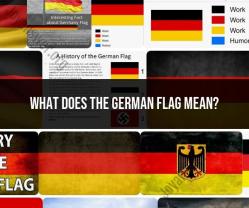What does the German flag mean?
The flag of Germany consists of three horizontal stripes of equal size, which are black, red, and gold from top to bottom. The colors of the German flag hold historical and symbolic significance:
Black: The black stripe at the top represents the German people's determination and strength. It's often associated with the dark times of Germany's history, including periods of struggle and conflict.
Red: The red stripe in the middle symbolizes the courage and valor of the German people. It's a color historically associated with various German states and regions.
Gold (Yellow): The gold or yellow stripe at the bottom signifies the unity and prosperity of the German nation. It represents the promise of a bright and prosperous future.
The colors of the German flag trace their origins to the early 19th century during the time of the Napoleonic Wars and the formation of the German Confederation. The flag's design was inspired by the uniforms of German soldiers who fought against Napoleon's forces. Over time, these colors became associated with the ideals of unity and the German nation.
The modern German flag was officially adopted on May 23, 1949, following the end of World War II and the establishment of the Federal Republic of Germany (West Germany). After the reunification of West and East Germany in 1990, the flag continued to be the national flag of the unified country.
The German flag is a symbol of unity, strength, courage, and the hope for a prosperous future. It is a representation of the values and aspirations of the German people and the nation as a whole.
The Symbolism and Meaning of the German Flag
The German flag is a tricolor of black, red, and gold. These colors have been associated with Germany since the late 18th century, and they were officially adopted as the national flag in 1919.
The black, red, and gold colors of the German flag are often interpreted to represent the following:
- Black: The black color is often associated with darkness, mystery, and seriousness. It can also represent power, strength, and determination.
- Red: The red color is often associated with passion, love, and excitement. It can also represent blood, violence, and danger.
- Gold: The gold color is often associated with wealth, luxury, and prosperity. It can also represent knowledge, wisdom, and enlightenment.
Historical Evolution of the German National Flag
The first German national flag was adopted in 1848, during the German Revolution. This flag was a black, red, and gold tricolor, and it was inspired by the colors of the uniforms of the Lützow Free Corps, a volunteer unit that fought against Napoleon in the Napoleonic Wars.
The black, red, and gold flag was banned by the Prussian government after the German Revolution failed in 1849. However, it remained a popular symbol of German unity and democracy. In 1919, after the end of World War I, the black, red, and gold flag was officially adopted as the national flag of the newly-formed Weimar Republic.
The black, red, and gold flag was banned again by the Nazi regime in 1933. The Nazis used their own flag, the swastika flag, as the national flag of Germany. After the end of World War II, the black, red, and gold flag was restored as the national flag of Germany.
The Colors and Their Significance in the German Flag
The black, red, and gold colors of the German flag have a number of different interpretations.
One common interpretation is that the colors represent the three major social classes of Germany in the 19th century: black for the aristocracy, red for the middle class, and gold for the working class.
Another interpretation is that the colors represent the three major principles of the German Revolution: black for unity, red for liberty, and gold for democracy.
Still another interpretation is that the colors represent the three major German virtues: black for power, red for love, and gold for wisdom.
Cultural and Political Interpretations of the German Flag
The German flag has a complex and sometimes controversial history. It has been used as a symbol of German unity, democracy, and freedom. However, it has also been used by authoritarian and extremist regimes.
Today, the German flag is widely used as a symbol of national pride and unity. It is flown at government buildings, schools, and other public places. It is also used at sporting events and other cultural events.
However, the German flag is also sometimes used by right-wing and neo-Nazi groups. This is because the black-white-red colors of the German Empire flag, which was used from 1871 to 1918, are associated with these groups.
Displaying and Using the German Flag Appropriately
The German flag should be displayed and used with respect. It should not be used for commercial purposes or for political propaganda. It should also not be displayed in a way that is disrespectful to the flag or to the German people.
Here are some tips for displaying and using the German flag appropriately:
- The German flag should be flown at its full height and should not be dragged on the ground.
- The German flag should not be used for advertising or for political propaganda.
- The German flag should not be displayed in a way that is disrespectful to the flag or to the German people.
If you are unsure about how to display or use the German flag appropriately, it is best to consult with a German government official or with a representative of a German cultural organization.













